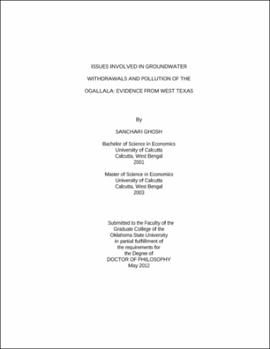| dc.contributor.advisor | Willett, Keith D. | |
| dc.contributor.author | Ghosh, Sanchari | |
| dc.date.accessioned | 2013-11-26T08:23:33Z | |
| dc.date.available | 2013-11-26T08:23:33Z | |
| dc.date.issued | 2012-05 | |
| dc.identifier.uri | https://hdl.handle.net/11244/6715 | |
| dc.description.abstract | Scope and Method of Study: The existing body of economic research dealing with groundwater extraction seems to focus only on that problem itself and does not view the exploitation of the aquifer and the corresponding pollution problem as a joint resource issue. This research attempts to fill in this gap, with the main objective being to assess the economic tradeoffs involved in groundwater quantity and quality management by capturing the dynamic behavior of the stock of groundwater as well as the stock of pollutant over a twenty year time period. The study uses simulated data for the estimation of production functions and nitrogen percolation functions and those estimates are used in a dynamic optimization framework to find out the level of water and nitrogen fertilizer applied per acre that maximizes net present value over a twenty year planning horizon. | |
| dc.description.abstract | Findings and Conclusions: Two sets of policies are developed for the joint management of groundwater quantity and quality and to evaluate the effect on the net present value of production. First a constraint is imposed on the use of nitrogen fertilizer per acre and then the price of nitrogen fertilizer is raised successively by 5% and 10%. Findings for Castro County in West Texas, point towards a favorable impact on groundwater quality whenever this practice of restricting the use of the polluting input is implemented. Secondly, certain policies aimed at raising the volume of water in storage along with maintaining some level of water quality are implemented. For Castro County, restriction on the terminal value of saturated thickness (or the water table) as well as buying out water rights show a 7 and 4 mg/l increase in the stock of pollutant with a saturated thickness decline by 6 feet less than the base level. However, the same policies have moderate impact upon water use and quality in Lubbock County which may point towards site specific policy recommendations The research concludes with a proposed agent based trading scenario on the lines of Vernon Smith's water deeds approach where two agents using the same inputs for production are allowed to trade after allocation of an initial set of permits for water withdrawal. The impact on the level and quality of water as well as the individual net revenues turns out to be superior when compared to a purely myopic policy of extracting as much of the inputs as possible. | |
| dc.format | application/pdf | |
| dc.language | en_US | |
| dc.rights | Copyright is held by the author who has granted the Oklahoma State University Library the non-exclusive right to share this material in its institutional repository. Contact Digital Library Services at lib-dls@okstate.edu or 405-744-9161 for the permission policy on the use, reproduction or distribution of this material. | |
| dc.title | Issues involved in groundwater withdrawals and pollution of the Ogallala: Evidence from West Texas | |
| dc.contributor.committeeMember | Rickman, Dan S. | |
| dc.contributor.committeeMember | Munasib, Abdul Baten Ahmed | |
| dc.contributor.committeeMember | Stoecker, Arthur | |
| osu.filename | Ghosh_okstate_0664D_12001 | |
| osu.accesstype | Open Access | |
| dc.type.genre | Dissertation | |
| dc.type.material | Text | |
| dc.subject.keywords | agriculture economics | |
| dc.subject.keywords | water resources management | |
| dc.subject.keywords | environmental economics | |
| thesis.degree.discipline | Economics and Legal Studies | |
| thesis.degree.grantor | Oklahoma State University | |
